Identification and Preferences of Spa Industry in Bali
on
E-Journal of Tourism Vol.10. No.2. (2023): 184-189
Identification and Preferences of Spa Industry in Bali
I Gusti Ayu Oka Suryawardani1*, Agung Suryawan Wiranatha2, Christine PETR3, I Gusti Raka Purbanto4, I Gusti Bagus Arya Yudiastina5
-
1 Faculty of Agriculture, Udayana University
-
2 Faculty of Agricultural Technology, Udayana University
-
3 Université Bretagne Sud, France
-
4 Faculty of Engineering, Udayana University
1,2,5 Centre of Excellence in Tourism, Udayana University
*Corresponding Author: suryawardani@unud.ac.id
DOI: https://doi.org/10.24922/eot.v10i2.108773
Article Info
Submitted:
July 15th 2023
Accepted:
September 20th 2023
Published:
September 30th 2023
Abstract
Wellness tourism allows a person to maintain their personal wellbeing, maintaining health and quality of life. People are more conscious of their wellness during the trip. Spa industry which is part of the wellness tourism are growing rapidly in Bali. The research aimed: i) to analyze characteristics of spa treatment in Bali and preferences of spa treatment by customers, ii) to identify products and services provided by traditional and Thalasso Spa in Bali. Research was conducted in Kuta, Seminyak, Canggu, Nusa Dua and Ubud as the center of spa treatment in Bali. Data was collected on January to April 2023 through interviewing 38 spa industries by using interview guides. Likert Scale was used to analyze the data in 1–5 scale. Data was analyzed by using qualitative approach. The results show that traditional spa treatments in Bali provide variety of products such as scrub, cream and lotion from herbs and natural ingredients from agriculture. Type of services available are traditional massage, aromatherapy, Thai massage, reflexology, hot stone massage and hot oil massage. Meanwhile, Thalasso is a therapy that is carried out using ingredients derived from the sea such as sea water, algae, seaweed, sand and sea mud and offers a wide range of spa treatments using technological spa equipment with excellent services. This therapy has only been found at the Grand Mirage Bali Resort since 1985 featuring an aqua medic pool with heated seaweed and sea water supported by 16 uniquely designed treatment rooms. The results also show that traditional massage is preferred by customers. Price competitiveness is one of the reasons why people choose traditional spa. Sense of traditional massage has also been preferred by customers.
Keywords: traditional massage; aromatherapy; oil massage; hot stone massage; Bali.
provided by traditional and Thalasso Spa in Bali. Research problems can be formulated as follows: (1) How are the characteristics of customer of spa and their preferences in choosing type of spa treatment in Bali?; (2) What are products and services provided by Thalasso Spa in Bali?
METHODS
Research was conducted in Kuta, Seminyak, Canggu, Nusa Dua and Ubud as the center of spa treatment in Bali. Data was collected on January to April 2023 through interviewing 38 spa industries by using interview guides. Likert Scale was used to analyze the data in 1–5 scale. Data was analyzed by using qualitative approach.
RESULTS AND DISCUSSION
Country of Origin of spa customer in Bali
Regarding country of origin of customer of spa in Bali, the results showed that among 38 spas, the highest percentage of customer was from Australia 17%, followed by Asia 15%, Indonesia 14%, USA 12%, France and Germany 11%, England 11% and Holland 9%. It can be seen in the Figure 1. The results indicated that Australia is always play an important role as target market of every single attraction in Bali. This can be understood that Australia is developed countries with the closest distance to Bali.
INTRODUCTION
Background
Tourism is still believed to increase business opportunity with the downward trend in Covid-19 cases. People can not wait to have their holiday to refresh their body, mind and soul, have spiritual balance and relaxation experiences. Spa industry which is part of the wellness tourism are growing rapidly in Bali. Wellness tourism has become a travel trend in recent years and is becoming an emerging market segment in some countries (Bushell and Sheldon, 2009). While medical tourists seek solely treatments for medical purposes, wellness tourism is assumed to be pursued by healthy people who care much about their health and seek physical fitness or improvement, spiritual balance, and cultural as well as relaxation experiences (Capellini, 2010). Wellness tourism is a niche market segment within the global travel and tourism industry and offers countless opportunities in product development and the future markets. Indonesia is a potential market for domestic and international wellness tourists (https://globalwellnessinsti-tute.org/industry-research/wellness).
While there are many cities and across the world offer wellness tourism, some tend to be more popular than others. Soedibyo (2009) stated that the number of spas in Bali is 600 spas, while in Indonesia it is estimated that there are around 1000 spas. On the other hand, spa which offer high technology, equipment and services are available in Bali. Paris which is one of the world's best destinations, has Thalasso Spa theraphy which is a therapy that is carried out using ingredients derived from the sea such as sea water itself, algae, seaweed, sand and sea mud. Thalasso therapy is also increasingly recognized, both as a beauty and health treatment. To improve competitiveness of spa tourism in Bali, efforts need to be undertaken. This study aimed to: i) to analyze characteristics of spa’ customer in Bali, ii) to identify products and services http://ojs.unud.ac.id/index.php/eot 185
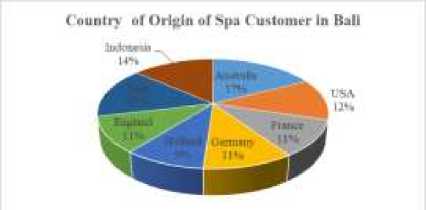
Figure 1. Country of origin of spa customer in Bali
Type of Spa Treatment Preferred by Consumer
The results showed that among 38 spas in Bali, traditional spa treatment reach the highest percentage preferred by consumer. It was about 35 %, followed by reflexology treatment 18 %, hot stone treatment 18 %, hot oil treatment 7 % and aromatherapy treatment and ayurveda 2% respectively. It can be seen in the Figure 2. This figure indicated that traditional spa treatment has the highest competitiveness in Bali that must be well managed to improve Balinese economy. Reflexology, hot stone, and hot oil treatment were also a good market for spa treatment in Bali. It can be understood that visitors enjoy wellness tourism to improve their body and mind while travelling in a long distance.
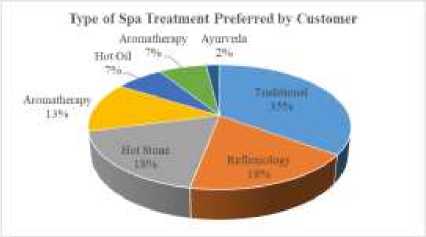
Figure 2. Type of spa treatment preferred by customer
Type of Spa Products
Agricultural products were the most popular spa product preferred by consumer. It was about 47.96% among 38 spas in Bali offered agricultural spa products, followed by imported lotion 10.41% and spa product from the sea 8.33%. The results also showed that 33.3% of spa in Bali offered mix products i.e. agricultural products, spa product from the sea as well as imported lotion. Variety of consumer’s need and want was the reason that spa in Bali offered variety of products as well to fulfil consumer needs. It can be seen in the Figure 3.
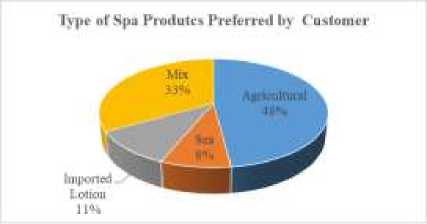
Figure 3. Type of spa products preferred by customer
Spa Ownership
Regarding spa ownership, the results showed that among 38 spas in Bali about 46.1% owned by Balinese. In contrast, 30.8% owned by non-Balinese and about 23.1% owned by foreigner. It can be seen in the Figure 4. The results showed worrying figure, because if the spa ownerships are not Balinese, meaning that the benefit economy of spa industry will going out to outside of Bali that will impacts in tourism leakage. As studies by Suryawardani (2014), Suryawardani et.al., (2016); Sury-awardani and Wiranatha (2016) found that tourism leakage happens when benefit of tourism going out to the outside of Balinese economy. This means that development of spa tourism will not be beneficial for Balinese community. Most of the benefit will leaks out to the outside of Bali. Efforts to strengthen local ownership of spa is crucial.
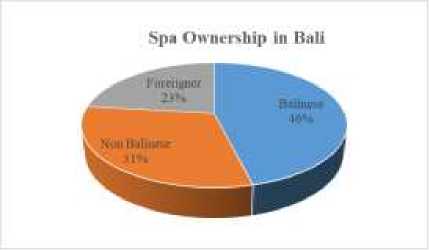
Figure 4. Spa ownership in Bali
Spa Management in Bali
Regarding the spa management in Bali, the results showed that among 38 spas, the highest percentage of spa management was managed by Balinese, about
78.38%, followed by non-Balinese about 18.92% and 2.7% of spa in Bali managed by foreigner. It can be seen in the Figure 5. The results also showed worrying figure. Even though the highest percentage of spa managed by Balinese, the role of non-Bali-nese and foreigner in managing spa in Bali showed a challenge by spa industry in Bali. Efforts in strengthen the role of local community is crucial.

Figure 5. Management of spa in Bali
Spa Therapist
Based on the spa therapist, the results showed that Balinese people play the highest role as spa therapist. It was about 65.8%, followed by non-Balinese 2.62 %, and mix figure between Balinese and nonBalinese, about 31.58%. It can be seen in the Figure 6. This is a good figure, meaning that the spa industry in Bali absorbs labor for the people of Bali
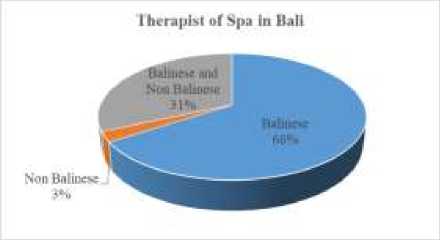
Figure 6. Spa therapist in Bali
Products and services provided by traditional and Thalasso spa in Bali
The results show that traditional spa treatments in Bali provide variety of products such as scrub, cream and lotion from herbs and natural ingredients from agriculture. Type of services available are
traditional massage, aromatherapy, Thai massage, reflexology, hot stone massage and hot oil massage. The results also show that traditional massage is still preferred by customers. Price competitiveness is one of the reasons why people choose traditional spa. Sense of traditional massage has also been preferred by customers.
Thalasso Bali Spa is the only Thal-asso Spa treatment in Bali situated at the Grand Mirage Bali Resort since 1985 which offering a wide range of spa treatments to provide the relaxation and rejuvenation of the body and soul. Featuring an aqua medic pool with heated seaweed and sea water with 16 uniquely designed treatment rooms. Excellent services were also found in this type of spa treatment.
These results indicated that even though traditional spa is preferred by spa customer, however, hospitality and services must be improved to gain customer’ satisfaction. Customer’ satisfaction is the important component in all businesses. Some studies regarding visitors’ satisfaction have been found as follow: Purnami and Suryawardani (2018) found that satisfaction significantly contributed to their desire to pay a revisit. In addition, Antonietta, et al., (2020) found that marketing mix and service quality had a significant effect on tourist satisfaction, and tourist satisfaction had a significant effect on revisit intention. Moreover, Hidayana, et al. (2019) found that visitors’ motivation had significant effect on tourist satisfaction. Participation of local communities must also be improved. Diversity of attraction which provide unique and innovative cultural products must be maintained.
The role of local wisdom as the main attention for tourists to visit Prai Ijing Traditional Village need to be maintained. Other study on service quality and satisfaction undertaken by Triyanti, et. al (2021) on Service Quality, Brand Attributes, Satisfaction and Loyalty of Guests Staying at Le Meridien Hotel Bali Jimbaran found that quality of service had a significant effect on satisfaction and satisfaction has a
significant effect on loyalty. Suggestions that can be made in this study that hotel should support loyalty, maintain, and pay close attention to brand attributes that need to be improved and guest mindset influence, as well as the should nd other aspects that can support and increase guest loyalty. Understanding visitors’ preferences are also important component in visitors’ behavior, such as a study by Dheanita, et. al (2022) found that tourists' preference i.e., cleanliness, price, attractiveness, service, recommendations, security, and promotion were the relative importance attribute during pandemic period in Bali. So that, research on customer’ satisfaction and loyalty as well as customer’ preferences on the spa industry need to be undertaken to fulfil customers’ need and wants. This study will give more information regarding supply and demand analysis of the spa industry in Bali.
CONCLUSION
Wellness tourism allows a person to maintain their personal wellbeing, maintaining health and quality of life. People are more conscious of their wellness during the trip. Spa industry which is part of the wellness tourism are growing rapidly in Bali. Wellness tourism has become a travel trend in recent years and is becoming an emerging market segment in some countries. Traditional spa treatments in Bali provide variety of products such as scrub, cream and lotion from herbs and natural ingredients from agriculture. Type of services available are traditional massage, aromatherapy, Thai massage, reflexology, hot stone massage and hot oil massage.
Sense of traditional massage is still preferred by customers, meanwhile, Thal-asso is a therapy that is carried out using ingredients derived from the sea such as sea water, algae, seaweed, sand and sea mud and offers a wide range of spa treatments using technological spa equipment with excellent services. This therapy has only been found at the Grand Mirage Bali http://ojs.unud.ac.id/index.php/eot 188
Resort since 1985 featuring an aqua medic pool with heated seaweed and sea water supported by 16 uniquely designed treatment rooms. These results indicated that even though traditional spa is preferred by spa customer, however, hospitality and services must be improved to gain customer’ satisfaction and loyalty
ACKNOWLEDGEMENT
This research has been supported by Centre of Excellence in Tourism, Research and Community Service Institution Uda-yana University, Bali, Indonesia.
REFERENCES
Antonietta G. D., I G. A. O. Suryawardani and A. S.Wiranatha. 2020. The Effect of Marketing Mix and Service Quality on Satisfaction and Revisit Intention to Kampung Coklat, Blitar Regency. E-Journal of Tourism Vol.7. No.2. (2020): 323-348. e-ISSN: 2407-392X. p-ISSN:
2541-0857.
Bushell, R. and P.J. Sheldon. 2009. Wellness and Tourism: Mind, Body, Spirit, Place, (Eds.). Cognizant Communication Corporation, New York. 310 P.47, ISBN: 978 1882 345517.
Capellini, S. 2010. The Complete Spa Book for Massage Therapists. Cen-gage Learning. Conell, J. 2006. Medical Tourism The Newest of Niches. Journal of Tourism Recreation Research, 31 (1), pp. 99-102.
Dheanita, S. O., I K. G. Bendesa⅛I G. A. O. Suryawardani, A. S. Wiranatha. 2022. The Preference of Domestic Tourist Towards the Tourism Destination During Pandemic Period in Bali. E-Journal of Tourism (9).2. (2022): 265-275. e-ISSN: 2407-392X. p-ISSN: 2541-0857.
Global Wellness Institute. 2010. Spas and the Global Wellness Market: Synergies and Opportunities.
https://globalwellnessinsti-tute.org/industry-research/spas-global- wellness-market/ cited-15/12/2021.
Global Wellness Institute. 2018. Wellness 2030: The New Technique of Happiness. https://globalwellnessinsti-tute.org/industry-research/well-ness-030/-cited- 19/12/2021.
Purnami, N. N. A. and I G. A. O. Surya-wardani. 2018. The Effect of the Quality of Services on the Visitors’ Satisfaction and Desire to Pay a Revisit to the Bali Pulina Agrotourism. E-Journal of Tourism Vol.5. No.2. (2018): 62-71. e-ISSN: 2407-392X. p-ISSN: 25410857.
Suryawardani, I G.A.O. 2014. Tourism leakage of accommodation in Bali. Journal on Hospitality and Tour-ism.Volume 13 (1): June 2014, ISSN: 1412-2073, p.3-18. 2014
http://journals.itb.ac.id/in-dex.php/ajht/article/view/3477
Suryawardani, I G. A. O., and A. S. Wiranatha. 2016. Strategy prioritization for sustainable tourism in Bali, Indonesia: Focusing on local agricultural products analytical hierarchy process (AHP) approach. The International Society for Southeast Asian Agricultural Sciences (ISSAAS), 22(1), June 2016, p: 96-110. ISSN 0859-3132.
https://www.cabdirect.org/cabdi-rect/abstract/20163257462
Suryawardani, I G.A.O., I K.G. Bendesa, M. Antara, D. Nursetyohadi and A.S.Wiranatha. 2016. Implementation of Social Accounting Matrix in Calculating Tourism Leakage of Accommodation in Bali. Journal of Applied Business and Economic Research. Vol (14). Number 13. 2016. Page: 9377-9405. ISSN: 0972 7302. http://serialsjour-
nals.com/abstract/50478_39-i_gusti_ayu_oka.pdf
Triyanti, A. D. L. P., A.S. Wiranatha, and I G. A. O. Suryawardani. 2021. Service Quality, Brand Attributes, Satisfaction and Loyalty of Guests Staying at Le Meridien Hotel Bali Jimbaran. E-Journal of Tourism Vol.8. No.1. (2021): 97-114. e-ISSN: 2407-392X. p-ISSN: 25410857.
http://ojs.unud.ac.id/index.php/eot
189
e-ISSN 2407-392X. p-ISSN 2541-0857
Discussion and feedback